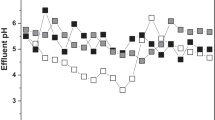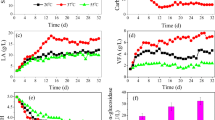Abstract
Fermentative H2 production from soybean protein processing wastewater (SPPW) was investigated in a four-compartment anaerobic baffled reactor (ABR) using anaerobic mixed cultures under continuous flow condition in the present study. After being inoculated with aerobic activated sludge and operated at the inoculants of 5.98 gVSS L−1, COD of 5000 mg L−1, HRT of 16 h and temperature of (35 ± 1) °C for 22 days, the ABR achieved stable ethanol-type fermentation. The specific hydrogen production rate of anaerobic activated sludge was 165 LH2 kg MLVSS−1 day−1, the substrate conversion rate was 600.83 LH2 kg COD−1and the COD removal efficiency was 44.73% at the stable operation status. The ABR system exhibited a better stability and higher hydrogen yields than continuous stirring tank reactor under the same operational condition. The experimental data documented the feasibility of substrate degradation along with molecular H2 generation utilizing SPPW as primary carbon source in the ABR system.





Similar content being viewed by others
References
Zecca, A., & Chiari, L. (2010). Fossil-fuel constraints on global warming. Energ Policy, 38, 1–3.
Schilling, M. A., & Esmundo, M. (2009). Technology S-curves in renewable energy alternatives: Analysis and implications for industry and government. Energ Policy, 37, 1767–1781.
Shafiee, S., & Topal, E. (2009). When will fossil fuel reserves be diminished? Energ Policy, 37, 181–189.
Akella, A. K., Saini, R. P., & Sharma, M. P. (2009). Social, economical and environmental impacts of renewable energy systems. Renew Energy, 34, 390–396.
Manish, S., & Banerjee, R. (2008). Comparison of biohydrogen production processes. International Journal Hydrogen Energy, 33, 279–286.
Luo, G., Xie, L., Zou, Z. H., Wang, W., & Zhou, Q. (2010). Evaluation of pretreatment methods on mixed inoculum for both batch and continuous thermophilic biohydrogen production from cassava stillage. Bioresource Technology, 101, 959–964.
Bhaskar, V. Y., Mohan, V. S., & Sarma, P. N. (2008). Effect of substrate loading rate of chemical wastewater on fermentative biohydrogen production in biofilm configured sequencing batch reactor. Bioresource Technology, 99, 6941–6948.
Mohan, V. S., Mohanakrishna, G., Goud, K. R., & Sarma, P. N. (2009). Acidogenic fermentation of vegetable based market waste to harness biohydrogen with simultaneous stabilization. Bioresource Technology, 100, 3061–3068.
Ntaikou, I., Kourmentza, C., Koutrouli, E. C., Stamatelatou, K., Zampraka, A., Kornaaros, M., et al. (2009). Exploitation of olive oil mill wastewater for combined biohydrogen and biopolymers production. Bioresource Technology, 100, 3724–3730.
Santos, A. B., Cervantes, F. J., & Van, L. J. B. (2007). Review paper on current technologies for decolourisation of textile wastewaters: Perspectives for anaerobic biotechnology. Bioresource Technology, 98, 2369–2385.
Liu, X. L., Ren, N. Q., & Yuan, Y. X. (2009). Performance of a periodic anaerobic baffled reactor fed on chinese traditional medicine industrial wastewater. Bioresource Technology, 100, 104–110.
Zhu, G.F., Li, J.Z., Wu, P., Jin, H.Z. and Wang, Z. The performance and phase separated characteristics of an anaerobic baffled reactor treating soybean protein processing wastewater. Bioresour. Technol. 99, 8027–8033
Xiao, B.Y. and Liu, J.X. Biological hydrogen production from sterilized sewage sludge by anaerobic self-fermentation. J. Hazard Mater. 168, 163–167
Franchi, E., Tosi, C., Scolla, G., Penna, G. D., Rodriguez, F., & Pedroni, P. M. (2004). Metabolically engineered Rhodobacter sphaeroides RV strains for improved biohydrogen photoproduction combined with disposal of food wastes. Marine Biotechnology, 6, 552–565.
Tang, G. L., Huang, J., Sun, Z. J., Tang, Q. Q., Yan, C. H., & Liu, G. Q. (2008). Biohydrogen production from cattle wastewater by enriched anaerobic mixed consortia: Influence of fermentation temperature and pH. Journal of Bioscience and Bioengineering, 106(1), 80–87.
Tanisho, S., & Shiwata, Y. (1994). Continuous hydrogen production from molasses by the bacterium Enterobacter aerogenes. International Journal Hydrogen Energy, 9, 807–812.
Li, C., & Fang, H. H. P. (2007). Fermentative hydrogen production from wastewater and solid wastes by mixed cultures. Critical Reviews in Environmental Science and Technology, 37, 1–39.
Matsumoto, M., & Nishimura, Y. (2007). Hydrogen production by fermentation using acetic acid and lactic acid. Journal of Bioscience and Bioengineering, 103(3), 236–241.
APHA. (1998). Standard methods for the examination of water and wastewater (20th ed.). Washington: American Public Health Association.
Chen, Y., Cheng, J. J., & Creamer, K. S. (2008). Inhibition of anaerobic digestion process: A review. Bioresource Technology, 99, 4044–4064.
Hutnan, M., Mrafkova, L., Drtil, M., & Derco, J. (1999). Methanogenic and nonmethanogenic activity of granulated sludge in anaerobic baffled reactor. Chemical Papers, 53(6), 374–378.
Ren, N. Q., Qin, Z., & Li, J. Z. (2003). Comparison and analysis of hydrogen production capacity with different acidogenic fermentative microflora. China Journal Environment Science China, 24(1), 70–74.
Van Ginkel, S., & Logan, B. E. (2005). Increased biological hydrogen production with reduced organic loading. Water Research, 39, 3819–3826.
Qin, Z., Ren, N. Q., Li, J. Z., & Yan, X. F. (2003). Superacid state of acidogenic phase and controlling strategy for recovery. Journal Harbin Institute of Technology, 35(9), 1105–1108.
Ren, N. Q., Chen, X. L., & Zhao, D. (2001). Control of fermentation types in continuous flow acidogenic reactors: effects of pH and redox potential. Journal Harbin Institute of Technology New Series, 8(2), 116–119.
Ren, N. Q., Wang, B. Z., & Huang, J. C. (1997). Ethanol-type fermentation from carbohydrate in high rate acidogenic reactor. Biotechnology and Bioengineering, 54, 197–200.
Bachmann, A., Beard, V. L., & McCarty, P. L. (1985). Performance characteristics of the anaerobic baffled reactor. Water Research, 19(1), 99–106.
Li, J. Z., Ren, N. Q., Qin, Z., Li, Y. F., Bao, H. X., & Jiang, P. (2004). Start up of hydrogen producing fermentation process with anaerobic activated sludge and acclimatization of the dominant ethanol-type fermentation population. High Technology Lett, 14(9), 90–94.
Hwang, M. H., Jang, N. J., Hyun, S. H., & Kim, I. S. (2004). Anaerobic biohydrogen production from ethanol fermentation: The role of pH. Journal of Biotechnology, 111, 297–309.
Fang, H. H. P., & Liu, H. (2002). Effect of pH on hydrogen production from glucose by a mixed culture. Bioresource Technology, 82, 87–93.
Khanal, S. K., Chen, W. H., Li, L., & Sung, S. (2004). Biological hydrogen production: effect of pH and intermediate products. International Journal Hydrogen Energy, 29, 1123–1131.
Li, J. Z., Li, B. K., Zhu, G. F., Ren, N. Q., Bo, L. X., & He, J. G. (2007). Hydrogen production from diluted molasses by anaerobic hydrogen producing bacteria in an anaerobic baffled reactor (ABR). International Journal Hydrogen Energy, 32, 3274–3283.
Li, J. Z., Zheng, G. C., He, J. G., Chang, S., & Qin, Z. (2009). Hydrogen-producing capability of anaerobic activated sludge in three types of fermentations in a continuous stirred-tank reactor. Biotechnology Advances, 27, 573–577.
Acknowledgments
The authors would like to thank the National Natural Science Foundation of China (Contract No. 50808152), Provincial Science Foundation of Fujian (Grant No. 2010 J01314) and the Knowledge Innovation Program of the Chinese Academy of Sciences (Grant No. KZCX2-EW-402-02) for their supports for this study.
Author information
Authors and Affiliations
Corresponding author
Rights and permissions
About this article
Cite this article
Zhu, Gf., Li, Jz. & Liu, Cx. Fermentative Hydrogen Production from Soybean Protein Processing Wastewater in an Anaerobic Baffled Reactor (ABR) Using Anaerobic Mixed Consortia. Appl Biochem Biotechnol 168, 91–105 (2012). https://doi.org/10.1007/s12010-011-9357-1
Received:
Accepted:
Published:
Issue Date:
DOI: https://doi.org/10.1007/s12010-011-9357-1




